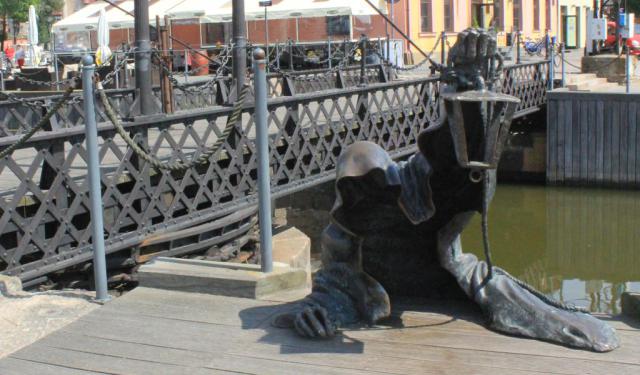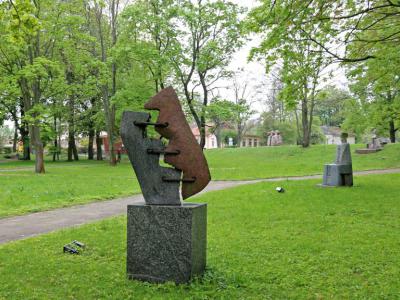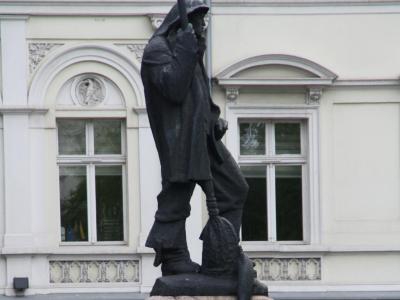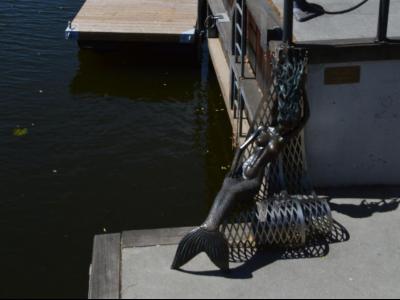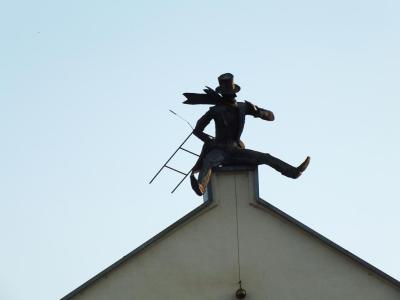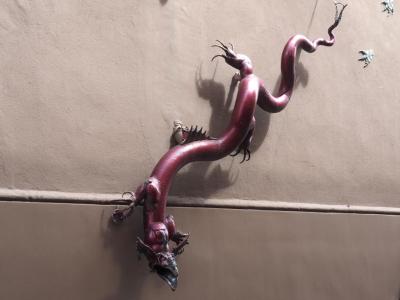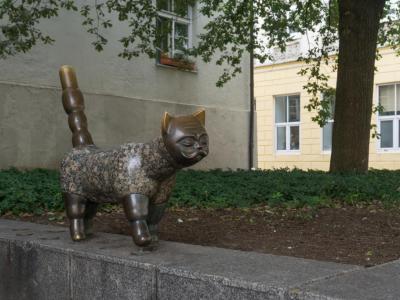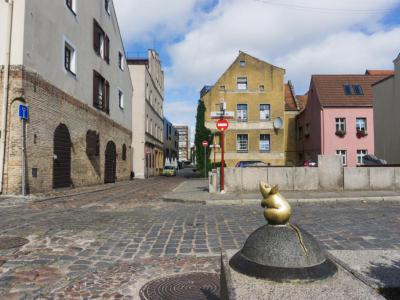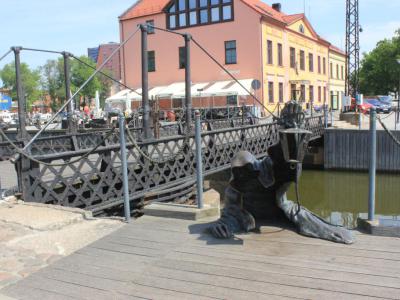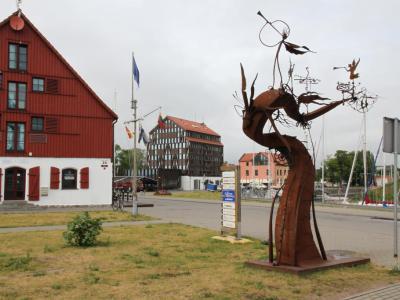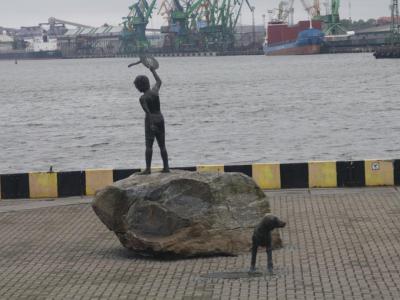Klaipeda Statues and Monuments Walk (Self Guided), Klaipeda
Founded by Germans in the mid-13th century, Klaipeda is the oldest city in Lithuania and quite big on historical and artistic heritage. The latter includes numerous statues and monuments, some of which are weird, some outstanding, and some simply amusing, collectively adding a great deal of charm to the city's cultural scene.
A notable location to find a wealth of sculptures in one place created by various artists is Martynas Mazvydas Sculpture Park.
Another significant landmark is the Monument to Fisherman, or Zvejys, which pays homage to the city's strong connection to fishing and the sea – both playing a vital role in Klaipeda's economy and identity.
Visitors can also admire The Little Mermaid sculpture, adding a touch of whimsy to the landscape. Similarly, Skulptur Kaminkretys, depicting a Chimney Sweep on the Roof, captures the charm of Klaipeda's architecture and traditions.
For those intrigued by mythical creatures, The Dragon offers an enchanting sight. Meanwhile, the Old Town Cat sculpture adds a playful element to the historic streets.
The city is also home to The Magic Mouse and The Black Ghost sculptures, both of which add an air of mystery and intrigue to Klaipeda's ambiance.
Furthermore, The Four Winds symbolizes the forces of nature that have shaped the city's landscape over the centuries. Lastly, the Childhood Dream invites visitors to reminisce about the innocence and wonder of youth.
Exploring these statues and monuments offers not only a visual feast but also a deeper understanding of the city's creative spirit and imagination. So, next time you find yourself in Klaipeda, be sure to seek out these attractive sculptures and experience the stories they have to tell.
A notable location to find a wealth of sculptures in one place created by various artists is Martynas Mazvydas Sculpture Park.
Another significant landmark is the Monument to Fisherman, or Zvejys, which pays homage to the city's strong connection to fishing and the sea – both playing a vital role in Klaipeda's economy and identity.
Visitors can also admire The Little Mermaid sculpture, adding a touch of whimsy to the landscape. Similarly, Skulptur Kaminkretys, depicting a Chimney Sweep on the Roof, captures the charm of Klaipeda's architecture and traditions.
For those intrigued by mythical creatures, The Dragon offers an enchanting sight. Meanwhile, the Old Town Cat sculpture adds a playful element to the historic streets.
The city is also home to The Magic Mouse and The Black Ghost sculptures, both of which add an air of mystery and intrigue to Klaipeda's ambiance.
Furthermore, The Four Winds symbolizes the forces of nature that have shaped the city's landscape over the centuries. Lastly, the Childhood Dream invites visitors to reminisce about the innocence and wonder of youth.
Exploring these statues and monuments offers not only a visual feast but also a deeper understanding of the city's creative spirit and imagination. So, next time you find yourself in Klaipeda, be sure to seek out these attractive sculptures and experience the stories they have to tell.
How it works: Download the app "GPSmyCity: Walks in 1K+ Cities" from Apple App Store or Google Play Store to your mobile phone or tablet. The app turns your mobile device into a personal tour guide and its built-in GPS navigation functions guide you from one tour stop to next. The app works offline, so no data plan is needed when traveling abroad.
Klaipeda Statues and Monuments Walk Map
Guide Name: Klaipeda Statues and Monuments Walk
Guide Location: Lithuania » Klaipeda (See other walking tours in Klaipeda)
Guide Type: Self-guided Walking Tour (Sightseeing)
# of Attractions: 10
Tour Duration: 2 Hour(s)
Travel Distance: 2.8 Km or 1.7 Miles
Author: DanaOffice
Sight(s) Featured in This Guide:
Guide Location: Lithuania » Klaipeda (See other walking tours in Klaipeda)
Guide Type: Self-guided Walking Tour (Sightseeing)
# of Attractions: 10
Tour Duration: 2 Hour(s)
Travel Distance: 2.8 Km or 1.7 Miles
Author: DanaOffice
Sight(s) Featured in This Guide:
- Martyno Mazvydo Skulpturu Parkas (Martynas Mazvydas Sculpture Park)
- Zvejys (Monument to Fisherman)
- Skulptur Undinele (Sculpture The Little Mermaid)
- Skulptur Kaminkretys (Sculpture Chimney Sweep on the Roof)
- Skulptur Slibinas (Sculpture The Dragon)
- Skulptur Senamiescio Katinas (Sculpture Old Town Cat)
- Skulptur Stebuklingas Peliukas (Sculpture The Magic Mouse)
- Skulptur Juodasis Vaiduoklis (Sculpture The Black Ghost)
- Skulptur Keturi Vejai (Sculpture The Four Winds)
- Vaikystes Svajone (Childhood Dream)
1) Martyno Mazvydo Skulpturu Parkas (Martynas Mazvydas Sculpture Park)
Spanning an L-shaped area of 10 hectares, Martynas Mazvydas Sculpture Park boasts a collection of 116 contemporary sculptures crafted by 61 Lithuanian artists between 1977 and 1991. Among the contributors are 10 laureates of the National Culture and Art Prize, making it a significant artistic showcase in Klaipėda's cultural landscape. In 1986, the park was rightfully designated as a natural monument of local significance.
The park's origins trace back to the former Klaipėda city cemetery, which served as the final resting place for approximately 40,000 individuals from 1820 until the 20th century. Today, the park stands as a testament to historical and cultural significance, overseen by the Klaipėda City Municipality and managed in terms of sculpture exhibition by the Museum of the History of Little Lithuania.
The Klaipėda Sculpture Park isn't just an art exhibition; it serves as a dynamic venue for various recreational and cultural events. From health exercises to contemporary art promotions, poetry readings, and educational events for children, the park buzzes with a vibrant cultural life. The Center of National Cultures, situated within the park, hosts diverse events such as exhibitions, multilingual literature readings, concerts, seminars, film screenings, and days dedicated to celebrating different national cultures.
In the western section of the park, visitors can discover a basketball court adjacent to a Napoleonic defensive structure, a fortified outdoor installation built in 1809. This historical installation not only provides a unique backdrop but also showcases a green interior space covered with trees and features a court at its summit.
The park's origins trace back to the former Klaipėda city cemetery, which served as the final resting place for approximately 40,000 individuals from 1820 until the 20th century. Today, the park stands as a testament to historical and cultural significance, overseen by the Klaipėda City Municipality and managed in terms of sculpture exhibition by the Museum of the History of Little Lithuania.
The Klaipėda Sculpture Park isn't just an art exhibition; it serves as a dynamic venue for various recreational and cultural events. From health exercises to contemporary art promotions, poetry readings, and educational events for children, the park buzzes with a vibrant cultural life. The Center of National Cultures, situated within the park, hosts diverse events such as exhibitions, multilingual literature readings, concerts, seminars, film screenings, and days dedicated to celebrating different national cultures.
In the western section of the park, visitors can discover a basketball court adjacent to a Napoleonic defensive structure, a fortified outdoor installation built in 1809. This historical installation not only provides a unique backdrop but also showcases a green interior space covered with trees and features a court at its summit.
2) Zvejys (Monument to Fisherman)
"The Fisherman" monument, standing proudly along the Danė embankment near Klaipėda's Town Hall building, is one of the oldest post-war sculptures in the city. Crafted by sculptor Kazimieras Kisiel and designed by architect Petras Šadauskas, this monumental figure is a testament to Klaipėda's enduring connection with its maritime heritage.
Perched atop a quadrangular base, the "Fisherman" sculpture reaches several meters in height, evoking a sense of strength and resilience. The base itself is made of local rock, a boulder retrieved from the depths of the Curonian Lagoon during the harbor entrance's deepening. This stone, having weathered the waters for an extended period, was chosen for its unique character.
Unveiled to the public on July 20, 1971, during the inaugural Fisherman's Day celebration, the monument portrays the fisherman as a symbolic figure, elevated by the waves. Its strategic placement facing the city is a deliberate choice to emphasize Klaipėda's strong fishing traditions. "The Fisherman" stands as both a visual tribute to the maritime heritage of Klaipėda and a representation of the city's enduring connection to the sea.
Perched atop a quadrangular base, the "Fisherman" sculpture reaches several meters in height, evoking a sense of strength and resilience. The base itself is made of local rock, a boulder retrieved from the depths of the Curonian Lagoon during the harbor entrance's deepening. This stone, having weathered the waters for an extended period, was chosen for its unique character.
Unveiled to the public on July 20, 1971, during the inaugural Fisherman's Day celebration, the monument portrays the fisherman as a symbolic figure, elevated by the waves. Its strategic placement facing the city is a deliberate choice to emphasize Klaipėda's strong fishing traditions. "The Fisherman" stands as both a visual tribute to the maritime heritage of Klaipėda and a representation of the city's enduring connection to the sea.
3) Skulptur Undinele (Sculpture The Little Mermaid)
Perched delicately on the Exchange Bridge, gracing the right quay of the Danė River, is the enchanting sculpture titled "Mermaid". This captivating piece emerged from the depths of the river, seemingly taking a moment of repose on the nets. The sculptural composition, introduced on January 15, 2015, adds a touch of marine charm to the city's landscape.
Crafted by the skilled hands of sculptor Klaudijus Pūdymas, the "Mermaid" is a testament to artistic creativity and a playful interpretation of the mythical tale of Jūratė and Kastytis. Comprising 140 kg of bronze, the sculpture stands 1.2 meters wide and reaches a height of 1.6 meters. Notably, the mermaid's tail is adorned with litas coins, adding a distinctive touch that resonates with the cultural and historical context.
This alluring mermaid is not merely a static piece; it carries a touch of magic. The sculptor suggests that the mermaid possesses mystical powers. Those who rub the snake entwined around her hand are said to have their wishes granted-a whimsical invitation for visitors to partake in the enchantment of folklore.
Crafted by the skilled hands of sculptor Klaudijus Pūdymas, the "Mermaid" is a testament to artistic creativity and a playful interpretation of the mythical tale of Jūratė and Kastytis. Comprising 140 kg of bronze, the sculpture stands 1.2 meters wide and reaches a height of 1.6 meters. Notably, the mermaid's tail is adorned with litas coins, adding a distinctive touch that resonates with the cultural and historical context.
This alluring mermaid is not merely a static piece; it carries a touch of magic. The sculptor suggests that the mermaid possesses mystical powers. Those who rub the snake entwined around her hand are said to have their wishes granted-a whimsical invitation for visitors to partake in the enchantment of folklore.
4) Skulptur Kaminkretys (Sculpture Chimney Sweep on the Roof)
Perched atop the roof of the "Žvejų" bar a whimsical bronze sculpture adds a touch of charm and luck to the city's old town. This delightful creation, titled "Chimney Sweep on the Roof" is a nod to tradition and a symbol of bringing happiness to the historic heart of Klaipėda.
The installation of this 2.4-meter-tall, approximately 300 kg sculpture was motivated by a desire to revive the old legend of chimney sweeps. Nestled alongside the iconic sailing ship "Meridianas," the sculpture stands as a unique emblem, not only adorning the rooftop but also contributing to the lively spirit of the city.
According to local lore, interacting with the sculpture is believed to bring good luck. A simple touch of the button attached to the wall of the building is thought to bestow good fortune upon those who engage with it. This interactive element transforms the artwork into more than just a static piece; it becomes a participatory experience for residents and visitors alike.
The tradition of chimney sweeps as bearers of good luck harks back to a bygone era when these soot-covered figures were a common sight in old cities. As urban landscapes transitioned to central heating, the chimney sweep profession dwindled. Yet, the enduring charm of the tradition lives on through sculptures like "Chimney Sweep on the Roof."
The installation of this 2.4-meter-tall, approximately 300 kg sculpture was motivated by a desire to revive the old legend of chimney sweeps. Nestled alongside the iconic sailing ship "Meridianas," the sculpture stands as a unique emblem, not only adorning the rooftop but also contributing to the lively spirit of the city.
According to local lore, interacting with the sculpture is believed to bring good luck. A simple touch of the button attached to the wall of the building is thought to bestow good fortune upon those who engage with it. This interactive element transforms the artwork into more than just a static piece; it becomes a participatory experience for residents and visitors alike.
The tradition of chimney sweeps as bearers of good luck harks back to a bygone era when these soot-covered figures were a common sight in old cities. As urban landscapes transitioned to central heating, the chimney sweep profession dwindled. Yet, the enduring charm of the tradition lives on through sculptures like "Chimney Sweep on the Roof."
5) Skulptur Slibinas (Sculpture The Dragon)
Standing as a mystical homage to the legend behind the origin of Klaipėda's name, the sculpture "The Dragon" weaves a tale of imagination, folklore, and artistic expression. Crafted from steel, bronze, and granite, this captivating artwork captures the essence of a local legend, inviting residents and visitors alike to ponder the city's mythical roots.
The sculpture, envisioned and created by artist Vytautas Karčiauskas, is a symbolic representation of the etymology of Klaipėda, derived from the words "Klampi pieda," loosely translated as a large creature clinging to the beach sand. The legend associated with the city's name narrates the story of a man discovering a giant foot while searching for his brother. The nature of the creature is left to the imagination, allowing for a rich tapestry of interpretations.
Inspired by the idea of a one-headed dragon from Lithuanian folk tales, Karčiauskas' dragon sculpture serves as a metaphorical link between various elements-earth and sky, water and fire. The dragon's form, characterized by a descending wall and water pouring from its jaws into a large foot, embodies a harmonious connection between different realms.
The sculpture, envisioned and created by artist Vytautas Karčiauskas, is a symbolic representation of the etymology of Klaipėda, derived from the words "Klampi pieda," loosely translated as a large creature clinging to the beach sand. The legend associated with the city's name narrates the story of a man discovering a giant foot while searching for his brother. The nature of the creature is left to the imagination, allowing for a rich tapestry of interpretations.
Inspired by the idea of a one-headed dragon from Lithuanian folk tales, Karčiauskas' dragon sculpture serves as a metaphorical link between various elements-earth and sky, water and fire. The dragon's form, characterized by a descending wall and water pouring from its jaws into a large foot, embodies a harmonious connection between different realms.
6) Skulptur Senamiescio Katinas (Sculpture Old Town Cat)
Nestled within the charming streets of Klaipėda's old town, the "Old Town Cat" sculpture has become an enduring and beloved fixture, capturing the hearts of locals and visitors alike. Crafted from granite in 1979 by artist Regimantas Midvikis, this unique sculpture portrays a cat adorned with a gentleman's face, adding a touch of whimsy and character to its surroundings.
Despite enduring the challenges of vandalism, with two instances of restoration following such incidents, the "Old Town Cat" has managed to reclaim its spot in the city's landscape. In the summer of 2006, during the celebration of the city's birthday, the feline figure found its way back to its original location on Kalvių Street, nestled beneath the branches of an oak tree. During this ceremony, the sculpture was bestowed with the name "Klaipėda," signifying its symbolic importance to the city.
Often affectionately referred to as the "Cat with a Gentleman's Face," this sculpture holds a special place in the hearts of those who encounter it. Beyond its aesthetic appeal, the "Old Town Cat" is said to exude a sense of coziness, further enhancing the quaint and charming atmosphere of Klaipėda's historic district.
Legend has it that the cat possesses secret powers, adding an air of mystery and intrigue to this delightful sculpture. For those who have the pleasure of crossing paths with the "Old Town Cat," the experience becomes a whimsical journey, and discovering its hidden enchantments becomes a delightful adventure in itself.
Despite enduring the challenges of vandalism, with two instances of restoration following such incidents, the "Old Town Cat" has managed to reclaim its spot in the city's landscape. In the summer of 2006, during the celebration of the city's birthday, the feline figure found its way back to its original location on Kalvių Street, nestled beneath the branches of an oak tree. During this ceremony, the sculpture was bestowed with the name "Klaipėda," signifying its symbolic importance to the city.
Often affectionately referred to as the "Cat with a Gentleman's Face," this sculpture holds a special place in the hearts of those who encounter it. Beyond its aesthetic appeal, the "Old Town Cat" is said to exude a sense of coziness, further enhancing the quaint and charming atmosphere of Klaipėda's historic district.
Legend has it that the cat possesses secret powers, adding an air of mystery and intrigue to this delightful sculpture. For those who have the pleasure of crossing paths with the "Old Town Cat," the experience becomes a whimsical journey, and discovering its hidden enchantments becomes a delightful adventure in itself.
7) Skulptur Stebuklingas Peliukas (Sculpture The Magic Mouse) (must see)
The Sculpture of The Magic Mouse graces the charming streets of Klaipėda's Old Town at the intersection of Kurpių and Kepejų streets. Crafted from a combination of bronze and stone, this miniature masterpiece was brought to life through the collaborative efforts of sculptors S. Jurkaus and S. Plotnikovas, with architectural input from V. Paulionis.
The magical mouse is more than just a delightful piece of art; it is believed to possess wish-fulfilling powers. Visitors are invited to whisper their heartfelt wishes into the mouse's ear, embracing the enchanting notion that, with belief and sincerity, their wishes will come true. The inscription surrounding the sculpture imparts a guiding message: "Turn thoughts into words - words will become miracles."
To ensure that the magical mouse captures the wishes of all who visit, its endearing feature includes oversized ears, symbolizing receptivity to the hopes and dreams shared by those who seek its magic. This whimsical sculpture, a testament to the artists' creativity and goodwill, stands as a symbol of positivity and the transformative power of belief.
Financed by the dedicated artists themselves, the Sculpture of The Magic Mouse adds a touch of wonder to Klaipėda's historic landscape, inviting locals and tourists alike to engage in the age-old tradition of making wishes and cherishing the magic found in the simplest of moments.
The magical mouse is more than just a delightful piece of art; it is believed to possess wish-fulfilling powers. Visitors are invited to whisper their heartfelt wishes into the mouse's ear, embracing the enchanting notion that, with belief and sincerity, their wishes will come true. The inscription surrounding the sculpture imparts a guiding message: "Turn thoughts into words - words will become miracles."
To ensure that the magical mouse captures the wishes of all who visit, its endearing feature includes oversized ears, symbolizing receptivity to the hopes and dreams shared by those who seek its magic. This whimsical sculpture, a testament to the artists' creativity and goodwill, stands as a symbol of positivity and the transformative power of belief.
Financed by the dedicated artists themselves, the Sculpture of The Magic Mouse adds a touch of wonder to Klaipėda's historic landscape, inviting locals and tourists alike to engage in the age-old tradition of making wishes and cherishing the magic found in the simplest of moments.
8) Skulptur Juodasis Vaiduoklis (Sculpture The Black Ghost) (must see)
Emerging from the shadows along Klaipėda's waterfront walkway, the enigmatic bronze figure known as "The Black Ghost" has been a source of both fascination and trepidation since its installation in 2010. Crafted by the skilled hands of sculptors Svajunas Jurkus and Sergejus Plotnikovas, this eerie sculpture stands at a height of 7.8 feet, with roughly half of its spectral form concealed below the waterfront walkway and the other half hauntingly visible above.
The Black Ghost, clad in a hooded robe, possesses a peculiar and expressive appearance despite the absence of facial features. The emptiness within the robe adds to the ghostly mystique, capturing the attention and imagination of onlookers.
The tale behind The Black Ghost is rooted in local legend, reaching back to the year 1595 when Hans von Heidi, a guard stationed at Klaipėda Castle, experienced a chilling encounter during his nightly rounds near the harbor. Suddenly, a hooded figure materialized near the water's edge. Rather than posing a threat, the spectral entity inquired about the city's grain and timber supplies. Von Heidi, taken aback, relayed that the city had sufficient provisions, prompting the ghostly figure to issue a warning that the existing supplies would prove inadequate. With this ominous message, the apparition vanished.
In the superstitious climate of the time, where belief in ghosts, witches, and other supernatural entities was prevalent, von Heidi dutifully reported his encounter to his superiors. Responding to the ghost's warning, the city took action to increase its stocks of timber and grain. The subsequent years brought hardships, but the people of Klaipėda, forewarned by the ghostly messenger, managed to weather the challenges.
Far from a malevolent Nazgûl-like wraith, The Black Ghost serves as a unique and haunting tribute to Klaipėda's spectral savior-a mysterious guardian akin to a spectral Casper, simultaneously frightening and protective, with a tale that weaves folklore into the fabric of the city's history.
The Black Ghost, clad in a hooded robe, possesses a peculiar and expressive appearance despite the absence of facial features. The emptiness within the robe adds to the ghostly mystique, capturing the attention and imagination of onlookers.
The tale behind The Black Ghost is rooted in local legend, reaching back to the year 1595 when Hans von Heidi, a guard stationed at Klaipėda Castle, experienced a chilling encounter during his nightly rounds near the harbor. Suddenly, a hooded figure materialized near the water's edge. Rather than posing a threat, the spectral entity inquired about the city's grain and timber supplies. Von Heidi, taken aback, relayed that the city had sufficient provisions, prompting the ghostly figure to issue a warning that the existing supplies would prove inadequate. With this ominous message, the apparition vanished.
In the superstitious climate of the time, where belief in ghosts, witches, and other supernatural entities was prevalent, von Heidi dutifully reported his encounter to his superiors. Responding to the ghost's warning, the city took action to increase its stocks of timber and grain. The subsequent years brought hardships, but the people of Klaipėda, forewarned by the ghostly messenger, managed to weather the challenges.
Far from a malevolent Nazgûl-like wraith, The Black Ghost serves as a unique and haunting tribute to Klaipėda's spectral savior-a mysterious guardian akin to a spectral Casper, simultaneously frightening and protective, with a tale that weaves folklore into the fabric of the city's history.
9) Skulptur Keturi Vejai (Sculpture The Four Winds)
Standing as a testament to the creative spirit and craftsmanship of blacksmiths, the sculpture titled "The Four Winds" has a fascinating origin rooted in the city's blacksmiths symposium.
The inaugural blacksmiths symposium, aptly named "The Four Winds," took place in Klaipėda in 2008, attracting skilled artisans from various corners of the world, including Lithuania, Latvia, Czech Republic, and Canada. During this collaborative gathering, an original composition titled "The Fifth Wind" emerged, created collectively by the participating master blacksmiths.
"The Four Winds" sculpture symbolizes the four primary winds-North, South, East, and West-and carries the essence of their elemental forces. Additionally, it represents the wind of Creation, often referred to as the fifth wind. This symbolic breeze flows from the sculpture towards the city, originating from the historical backdrop of Klaipėda Castle.
Throughout its history, Klaipėda Castle held a prominent defensive position, boasting advanced fortifications in Prussia during the mid-18th century. However, its military significance waned after the conclusion of the Seven Years' War. In the early 20th century, industrial buildings were introduced within the castle's territory, marking a shift from military to industrial use.
The inaugural blacksmiths symposium, aptly named "The Four Winds," took place in Klaipėda in 2008, attracting skilled artisans from various corners of the world, including Lithuania, Latvia, Czech Republic, and Canada. During this collaborative gathering, an original composition titled "The Fifth Wind" emerged, created collectively by the participating master blacksmiths.
"The Four Winds" sculpture symbolizes the four primary winds-North, South, East, and West-and carries the essence of their elemental forces. Additionally, it represents the wind of Creation, often referred to as the fifth wind. This symbolic breeze flows from the sculpture towards the city, originating from the historical backdrop of Klaipėda Castle.
Throughout its history, Klaipėda Castle held a prominent defensive position, boasting advanced fortifications in Prussia during the mid-18th century. However, its military significance waned after the conclusion of the Seven Years' War. In the early 20th century, industrial buildings were introduced within the castle's territory, marking a shift from military to industrial use.
10) Vaikystes Svajone (Childhood Dream)
Nestled within the vibrant ambiance of the Klaipėda Port cruise terminal, the sculptural marvel known as "Childhood Dream" is a poignant embodiment of the most enchanting and significant dreams that take root in the fertile soil of childhood. Positioned at the arrival point of grand cruise ships, where townspeople and city guests often congregate, this sculptural composition adds a touch of whimsy to the port's surroundings.
The artistic creation of "Childhood Dream" is credited to the collaborative efforts of Klaipėda's talented artists, Svajūnas Jurkus and Vytautas Paulionis. Generously donated to the port city, the sculpture is a heartfelt gift to the community, intended to serve the singular purpose of adorning and enhancing the cityscape.
The composition features a young boy, perched upon a sizable stone, playfully interacting with a graceful hound held firmly by a leash. In a charming gesture, the boy waves a sailor's cap at passing ships, creating a scene that evokes a sense of innocence, wonder, and the universal joy associated with childhood dreams. The natural height of the sculpture, with the boy and his canine companion standing at 140 cm, ensures that the delightful tableau is visible from a distance, capturing the attention and admiration of those traversing the waters of the lagoon.
The artistic creation of "Childhood Dream" is credited to the collaborative efforts of Klaipėda's talented artists, Svajūnas Jurkus and Vytautas Paulionis. Generously donated to the port city, the sculpture is a heartfelt gift to the community, intended to serve the singular purpose of adorning and enhancing the cityscape.
The composition features a young boy, perched upon a sizable stone, playfully interacting with a graceful hound held firmly by a leash. In a charming gesture, the boy waves a sailor's cap at passing ships, creating a scene that evokes a sense of innocence, wonder, and the universal joy associated with childhood dreams. The natural height of the sculpture, with the boy and his canine companion standing at 140 cm, ensures that the delightful tableau is visible from a distance, capturing the attention and admiration of those traversing the waters of the lagoon.
Walking Tours in Klaipeda, Lithuania
Create Your Own Walk in Klaipeda
Creating your own self-guided walk in Klaipeda is easy and fun. Choose the city attractions that you want to see and a walk route map will be created just for you. You can even set your hotel as the start point of the walk.
Klaipeda Introduction Walking Tour
Welcome to Klaipeda, a captivating city on the Baltic Sea coast of Lithuania! Despite being the country's third-largest city, Klaipeda often escapes the attention of tourists who might only stop by briefly before heading straight to the sea and sand dunes of the Curonian Spit.
The city has a complex history, partially due to the strategic importance of its ice-free port at the mouth of... view more
Tour Duration: 2 Hour(s)
Travel Distance: 3.4 Km or 2.1 Miles
The city has a complex history, partially due to the strategic importance of its ice-free port at the mouth of... view more
Tour Duration: 2 Hour(s)
Travel Distance: 3.4 Km or 2.1 Miles
The Most Popular Cities
/ view all
